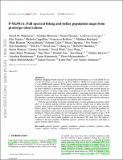Files in this item
P-MaNGA : full spectral fitting and stellar population maps from prototype observations
Item metadata
| dc.contributor.author | Wilkinson, David M. | |
| dc.contributor.author | Maraston, Claudia | |
| dc.contributor.author | Thomas, Daniel | |
| dc.contributor.author | Coccato, Lodovico | |
| dc.contributor.author | Tojeiro, Rita | |
| dc.contributor.author | Cappellari, Michele | |
| dc.contributor.author | Belfiore, Francesco | |
| dc.contributor.author | Bershady, Matthew | |
| dc.contributor.author | Blanton, Mike | |
| dc.contributor.author | Bundy, Kevin | |
| dc.contributor.author | Cales, Sabrina | |
| dc.contributor.author | Cherinka, Brian | |
| dc.contributor.author | Drory, Niv | |
| dc.contributor.author | Emsellem, Eric | |
| dc.contributor.author | Fu, Hai | |
| dc.contributor.author | Law, David | |
| dc.contributor.author | Li, Cheng | |
| dc.contributor.author | Maiolino, Roberto | |
| dc.contributor.author | Masters, Karen | |
| dc.contributor.author | Tremonti, Christy | |
| dc.contributor.author | Wake, David | |
| dc.contributor.author | Wang, Enci | |
| dc.contributor.author | Weijmans, Anne-Marie | |
| dc.contributor.author | Xiao, Ting | |
| dc.contributor.author | Yan, Renbin | |
| dc.contributor.author | Zhang, Kai | |
| dc.contributor.author | Bizyaev, Dmitry | |
| dc.contributor.author | Brinkmann, Jonathan | |
| dc.contributor.author | Kinemuchi, Karen | |
| dc.contributor.author | Malanushenko, Elena | |
| dc.contributor.author | Malanushenko, Viktor | |
| dc.contributor.author | Oravetz, Daniel | |
| dc.contributor.author | Pan, Kaike | |
| dc.contributor.author | Simmons, Audrey | |
| dc.date.accessioned | 2015-03-11T09:31:10Z | |
| dc.date.available | 2015-03-11T09:31:10Z | |
| dc.date.issued | 2015-05-01 | |
| dc.identifier | 173639356 | |
| dc.identifier | 48f9d9ac-781a-4903-ad20-ec38a1143101 | |
| dc.identifier | 84929995064 | |
| dc.identifier | 000355345600025 | |
| dc.identifier.citation | Wilkinson , D M , Maraston , C , Thomas , D , Coccato , L , Tojeiro , R , Cappellari , M , Belfiore , F , Bershady , M , Blanton , M , Bundy , K , Cales , S , Cherinka , B , Drory , N , Emsellem , E , Fu , H , Law , D , Li , C , Maiolino , R , Masters , K , Tremonti , C , Wake , D , Wang , E , Weijmans , A-M , Xiao , T , Yan , R , Zhang , K , Bizyaev , D , Brinkmann , J , Kinemuchi , K , Malanushenko , E , Malanushenko , V , Oravetz , D , Pan , K & Simmons , A 2015 , ' P-MaNGA : full spectral fitting and stellar population maps from prototype observations ' , Monthly Notices of the Royal Astronomical Society , vol. 449 , no. 1 , pp. 328-360 . https://doi.org/10.1093/mnras/stv301 | en |
| dc.identifier.issn | 0035-8711 | |
| dc.identifier.other | BibCode: 2015arXiv150301124W | |
| dc.identifier.other | ORCID: /0000-0002-5908-6852/work/40233501 | |
| dc.identifier.uri | https://hdl.handle.net/10023/6202 | |
| dc.description | MC acknowledges support from a Royal Society University Research Fellowship. | en |
| dc.description.abstract | MaNGA (Mapping Nearby Galaxies at Apache Point Observatory) is a 6-yearSDSS-IV survey that will obtain resolved spectroscopy from 3600 Å to10300 Å for a representative sample of over 10,000 nearby galaxies.In this paper, we derive spatially resolved stellar population properties and radial gradients by performing full spectral fitting of observed galaxy spectra from P-MaNGA, a prototype of the MaNGA instrument. These data include spectra for eighteen galaxies, covering a large range of morphological type. We derive age, metallicity, dust and stellar mass maps, and their radial gradients, using high spectral-resolution stellar population models, and assess the impact of varying the stellar library input to the models. We introduce a method to determine dust extinction which is able to give smooth stellar mass maps even in cases of high and spatially non-uniform dust attenuation.With the spectral fitting we produce detailed maps of stellar population properties which allow us to identify galactic features among this diverse sample such as spiral structure, smooth radial profiles with little azimuthal structure in spheroidal galaxies, and spatially distinct galaxy sub-components. In agreement with the literature, we find the gradients for galaxies identified as early-type to be on average flat in age, and negative (- 0.15 dex / Re ) in metallicity,whereas the gradients for late-type galaxies are on average negative in age (- 0.39 dex / Re ) and flat in metallicity. We demonstrate howdifferent levels of data quality change the precision with which radialgradients can be measured. We show how this analysis, extended to thelarge numbers of MaNGA galaxies, will have the potential to shed lighton galaxy structure and evolution. | |
| dc.format.extent | 12535216 | |
| dc.language.iso | eng | |
| dc.relation.ispartof | Monthly Notices of the Royal Astronomical Society | en |
| dc.subject | Techniques: spectroscopic | en |
| dc.subject | Galaxies: evolution | en |
| dc.subject | Galaxies: formation | en |
| dc.subject | Galaxies: general | en |
| dc.subject | Galaxies: stellar content | en |
| dc.subject | Galaxies: structure | en |
| dc.subject | QB Astronomy | en |
| dc.subject | QC Physics | en |
| dc.subject | 3rd-DAS | en |
| dc.subject.lcc | QB | en |
| dc.subject.lcc | QC | en |
| dc.title | P-MaNGA : full spectral fitting and stellar population maps from prototype observations | en |
| dc.type | Journal article | en |
| dc.contributor.institution | University of St Andrews. School of Physics and Astronomy | en |
| dc.identifier.doi | https://doi.org/10.1093/mnras/stv301 | |
| dc.description.status | Peer reviewed | en |
| dc.identifier.url | http://adsabs.harvard.edu/abs/2015arXiv150301124W | en |
This item appears in the following Collection(s)
Items in the St Andrews Research Repository are protected by copyright, with all rights reserved, unless otherwise indicated.

